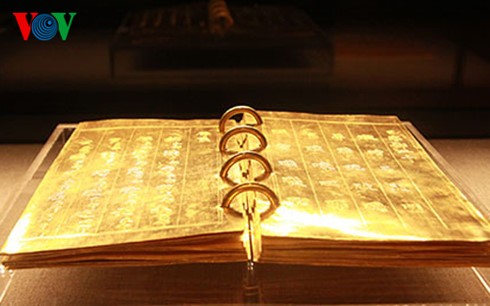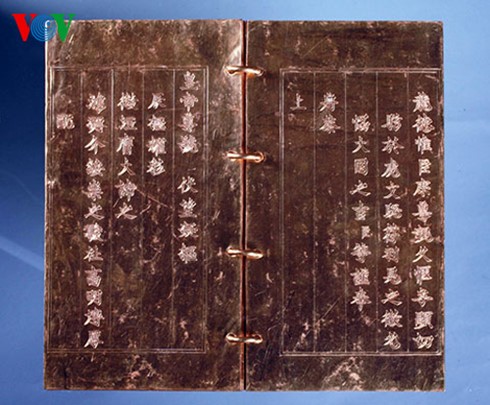(VOVworld)- For the first time, the National Museum of Vietnamese History is exhibiting precious books of the Nguyen dynasty (1802-1945). Historians say this collection of books is of economic, historical and cultural significance, exemplifying the marvelous skills of the royal craftsmen.
 |
The exhibit entitled “Royal treasures – Golden books of the Nguyen dynasty” includes 22 of the 94 books created under the Nguyen Kings, the last dynasty in Vietnam, which are being preserved by the National Museum of Vietnamese History. Since 1945 when King Bao Dai abdicated, the museum has collected more than 3,000 precious items of this dynasty. On display are also 10 related objects and 2 book boxes, all are made of precious metals and subtly engraved. Nguyen Quoc Huu of the National Museum of Vietnamese History said the golden books are special ancient documents which recorded the royal court’s political events and rituals like the Emperor’s ascension to the throne, naming the prince, the queen, and rewarding, promoting, or conferring a title on a royal family member or other prominent person. Huu said some of the golden books in the collection have golden objects attached which were made at the same time: “These are invaluable heritage items of the Nguyen dynasty left for future generations. They are valuable because of the gold and because they are unique art works. The best craftsmen of Vietnam were called to work at the royal court’s workshop to produce the books. These items are ideologically significant because they honour the filial piety advocated by the Nguyen dynasty. Each book is an independent document about a character. The collection of books helps us better understand the personalities of the Nguyen dynasty”.
 |
| A book records the ascension to throne of King Gia Long in 1806 in Hue |
The books are made of gold or gilded, in the shape of a quadrangle with covers decorated with a dragon or phoenix. Dr. Phan Thanh Hai, Director of the Hue Relics Conservation Center, highlights the books’ artistic uniqueness: “The books are precious thanks to their meticulous production from material selection, to bookbinding to presentation. Book presentation was done by calligraphy masters. From a sample, craftsmen carved the words onto gold sheets or gilded metal sheets. The work was meticulous and done under close supervision. When finished, these art works were almost perfect. But starting with the Emperor Dong Khanh (1885-1889) because of the royal court’s financial difficulties, the golden books, stamps and seals became less elaborate. The items themselves reflected rising and falling fortunes of the Nguyen dynasty”.
According to Dr. Phan Thanh Hai, the majority of Vietnam’s existing golden books belong to the Nguyen dynasty and the 22 books on display deserve to be recognized as national treasures: “There are prominent works among the exhibited items. For example, this seal was cast in the reign of Nguyen Phuc Chu in 1709. This was the first royal seal proclaiming Vietnam’s sovereignty. One golden book, the biggest book of the Nguyen dynasty, has a carved 20-word poem created by King Minh Mang and handed down through 20 kings. The book, which consists of 15 pages, is the heaviest and most aesthetic”.
In September, after being exhibited at the National Museum of Vietnamese History, the collection will move to Hue and will be published in reproduction by the end of this year.